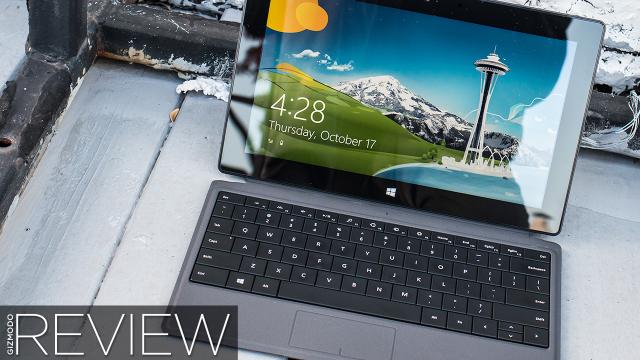The original Surface Pro was many things, but chief among them was strange. Not only did it deftly — if not quite perfectly — straddle the line between tablet and laptop, but it also straddled the line between futurist ideal and problematic product. This time around the Surface Pro 2 is packing plenty of practical improvements, but as a concept it’s still on shaky ground.
What Is It?
Microsoft’s second stab at its One Device to Rule Them All. A tablet that’s a laptop! A laptop that’s a tablet! A nearly shot-for-shot remake of a blockbuster-budget movie that was a box office flop.
Who Is It For?
Folks who loathe the thought of having a laptop and then also a tablet. People who need a small, full-powered, portable computer in the sveltest form possible. Artists who want something portable and pressure sensitive to draw on. Future people.
Why It Matters
Much like Windows 8.1, the Surface Pro 2 represents an opportunity for Microsoft to finesse its brute-force evolution. Windows 8, Surface Pro and Surface RT were all part of one big step forward, a veritable leap all the way to the endgame of tablet-PC hybridisation.
How Microsoft approaches the Surface Pro 2 tells us whether it thinks it’s time to backtrack or push forward. Or, as the case may be, to stand mostly still, tapping its foot, glancing at its watch, and waiting for the demands of the present to catch up with its vision of the future.
Design
The Surface Pro 2 is virtually identical to its predecessor. Both have the same 10-inch 1080p screen bolted to the same wonderfully designed but slightly chunky body. Both weigh in at a hefty-for-a-tablet-but-not-unreasonable-for-a-laptop 907 grams. For context, a full-size, latest iPad weighs in at just under a 700 grams, where a 11-inch Macbook Air weighs in at 1.1kg. That Surface Pro 2 splits the difference so nicely is an appropriate enough metaphor that you’d think it was intentional.
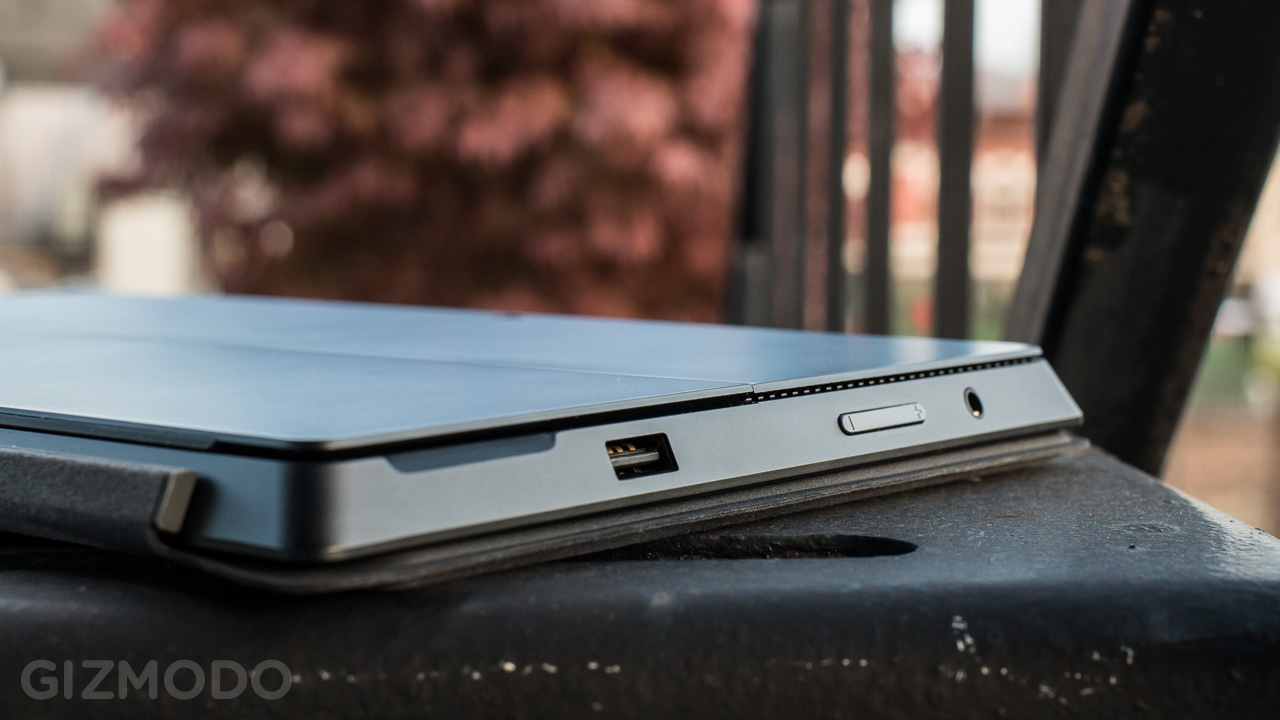
Both generations of Surface Pro have the same, sturdy, striking black magnesium housing, with the same ports in and the same buttons in the same places. At a glance, you’d be hard pressed to tell them apart. None of which is bad; the Surface Pro was and remains a beautiful bit of hardware.
The differences that do exist are subtle. The Surface Pro 2, like its underpowered second-generation sibling Surface 2 tablet, has a kickstand with not one but two(!) settings, a fix for the limiting binary kickstand from the last go ’round. The Surface Pro 2 also has new guts (a 4th Gen Intel Core i5 4200-U processor) because that’s what you do when you refresh a laptop.
The most noteworthy element of the design this time around, though, is that nearly everything has stayed the same. The Surface Pro 2 isn’t quite a carbon copy, but it’s close in a way that exudes either extreme confidence or a lack of inspiration. Given how much Microsoft has riding on Surface, it’s probably safer to assume the former.
Using It
The general experience of using the Surface Pro 2 — in all its glorious future-looking weirdness — is in large part the same as it was last year, and Microsoft’s cool reluctance to try and throw any sort of curve balls is in some ways as notable as a major overhaul would have been. The Surface Pro was the business-focused aspect Microsoft’s pitch for the “laptop” of tomorrow, and in broad terms the Surface Pro 2 is that same sell, again. The few tweaks that it did get affect the Pro’s body, but not its soul.
The biggest of those changes, and the only functional difference in its physical design, is that two-stage kickstand. It’s great! You heard it here first: two settings is better than one. The new 40-degree angle is in fact a better angle for laps, as it aims the screen at your eyes instead of your nipples. But while that improvement alone makes Surface Pro lap-work more serviceable, it doesn’t make it good, or fun, or anything you’d particularly want to do.
There’s still a certain precariousness to balancing the Surface Pro 2 — even with the improved angle, it’s still a balancing act — on your knees. And sure, you might be better off just switching to tablet mode at that point, but it’s a still a little irritating that using a laptop replacement on your lap is still so uncomfortable.
It’s also possible (and fairly easy) to accidentally slip the Pro 2 from its first, taller kickstand position to its wider one while you’re trying to insert some headphones or a display plug and exerting some downward pressure. This is not a huge deal, but it’s enough to give you a minor heart attack. Every time. Having that second setting is ultimately worth it, but the trade-off is losing the wonderful sturdiness of the original one-setting kickstand.
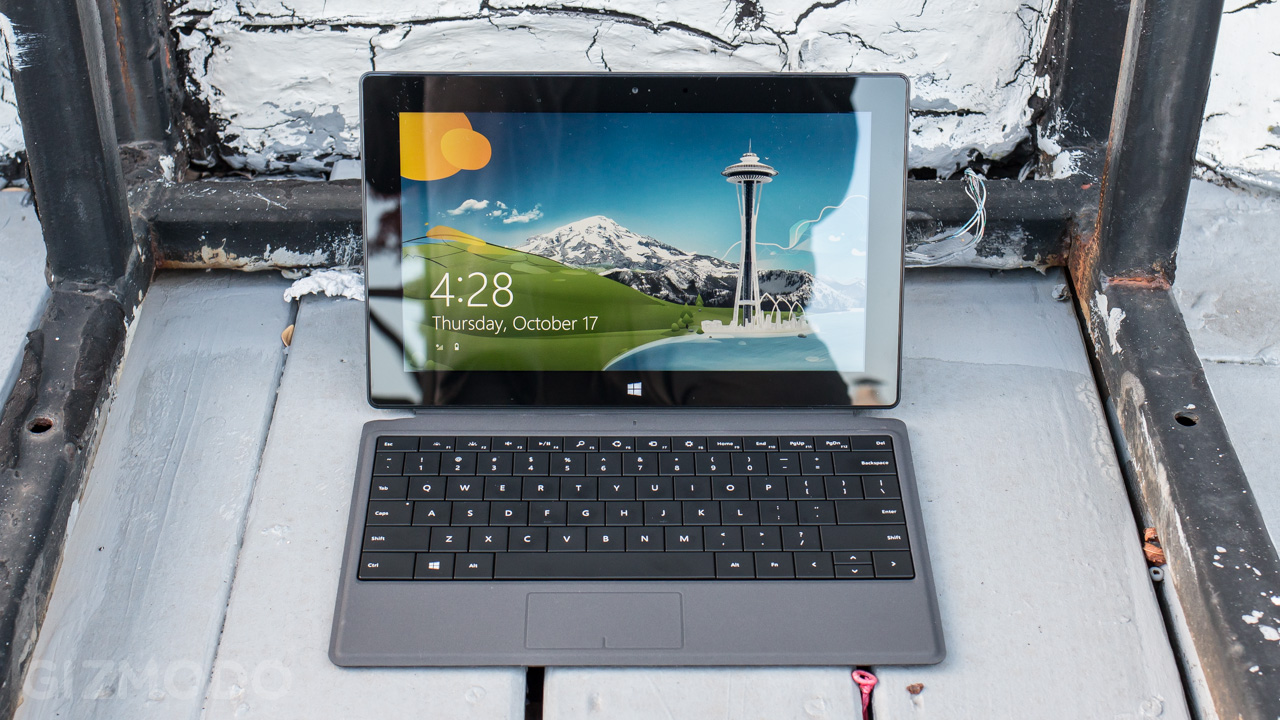
The Pro 2’s improved guts are exactly the nice step up that you’d expect them to be. The original Pro was no slouch in this department, and its Ivy Bridge Core i5 was more than enough to make it a trusty and capable computer and one hell of a zippy tablet. The new Haswell Core i5 is even better. It’s worth noting, though, that the performance gains are virtually unnoticeable when you’re loading up Metro apps or doing anything tablety, because Surface Pro was already more powerful than it needed to be for that.
Likewise, for running more standard desktop applications, whether it’s Photoshop or video games with not particularly demanding settings, the Surface Pro 2 is more than worth its weight in computing power. We were able to run older-but still modern games like Crysis 2 and Borderlands 2 well on high settings. And more modern games like Bioshock Infinite ad medium-to-low with ano problems.
Then, of course, it can handle day-to-day use admirably too, although the battery power leaves a little to be desired. We were able to squeeze three and a half hours of generating internet for Gizmodo out of a single charge, juggling some 10-15 open Chrome tabs and pushing video out to an additional monitor. This is almost the same as we got out of the original Surface Pro, which is a little odd considering Intel’s Haswell is such a battery saving monster. Likewise, the Pro 2 performed almost identically to the Pro in a 10-hour YouTube video test, giving up at just over two and a half hours, despite fairing better in situations that seem like they should be more intense.
It also helps that the Surface Pro 2 will run Windows 8.1 of the box, which offers a bunch of little changes to help beef up Windows 8’s not-Metro-but-god-damn-it-we-will-call-it-Metro-forever tablet side. This helps because — and this is kind of the big catch with the Surface Pro — Metro and its touch-friendly tiles is your tablet mode.
Yes, you can use the traditional desktop interface with the device in tablet mode. You will attempt this over and over again. It will drive you nuts. Between the smallness of a non-touch-centric UI and weird touch behaviour where your stupid fat fingers won’t do what you want them to do in applications like desktop Chrome, desktop mode without the painfully-easy-to-lose stylus is hopeless.
And then you’ll pull up some Metro apps and think to yourself “Why do I need a Core i5 in this tablet again? It just makes it bigger and also heavier and more expensive and also pretty warmish virtually all the time.” And the answer will be that you don’t need it at all, until you remind yourself that you sometimes use your fat, hot, pricey, overpowered tablet as a laptop computer. Just not right now.
Accessories
Touch and Type Cover 2
The biggest leaps for Surface Pro 2 actually come from its accessories. Like, the Touch Cover 2 is actually good for typing! Yes, the weirdness of pounding on a flat surface with no moving parts persists. It is still perilously easy to wander off course, type some gibberish, fill your screen with as you attempt to find backspace, and wind up swearing. But the Touch Cover 2 is somehow instantly more intuitive than it was before. It helps that, apparently, this new version has some 1,100 touch sensors instead of the meagre 80 (!) that were in the old one. You’ll notice.
Specs aside, Touch Cover 2 just feels better, and so long as you can keep yourself anchored to the home keys, it’s fairly easy to just go to town. There’s still a learning curve — there always will be — but now it’s more like days than weeks. Maybe even hours.
It’s not all good news, though. The original Touch Cover was too flimsy, and its successor isn’t much sturdier. Side by side, it seems that the Touch Cover 2 might actually have more flex to it. That’s all kinds of impressive from an engineering standpoint, but it’s kind of a bummer when you’re trying to peck at it on your lap.
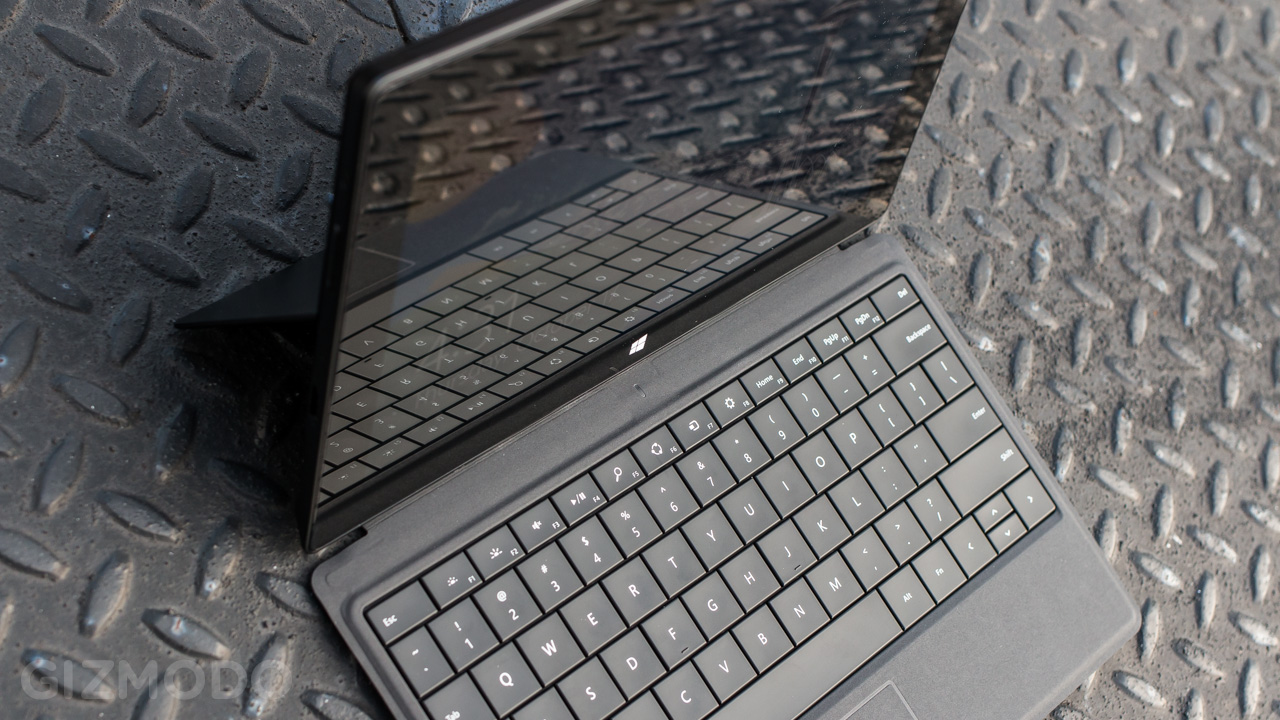
The Type Cover 2 is a slick little update as well. Its new keys have less travel that the old version, and the shallower press-depth makes it feel more solid. That’s a blessing and a curse actually, because it lulls you into a sort of false sense of security and you’ll find yourself on a typo-riddled sprint as you try to run before you can walk. We actually found it easier to type on the Touch Cover at times, because it demands a sort of careful concentration that keeps you on track. But once you get the hang of it — again, a matter of a day, or a couple of hours — it’s possible, feasible, and comfortable to really cook on the thing.
As an added bonus, both covers have backlights now, fairly powerful and even ones, considering that the addition didn’t add so much as a millimetre to either cover. According to Microsoft, the new Touch Cover is actually thinner than it used to be, but the change is virtually impossible to notice. The Touch Cover, with its new army of sensors, is also theoretically able to support keyboard-wide swipey gestures, like some big trackpad, but we couldn’t find anything that showed this off particularly well, or any compelling reason we’d want to.
On the flip side, the actual touchpads on both the Type and Touch Cover are still too small. Of course, we’re talking about a touch-enabled device here, so it’s not the end of the world. But just because you have a ready alternative doesn’t mean an existing part should get away with being sub-par. Besides, old habits die hard, and it’s important to have a precision pointer option when you’re navigating the desktop. Sure, there’s also the stylus, but…shit…where did I put that again? Damn it. It’s gotta be around here somewhere.
Stylus
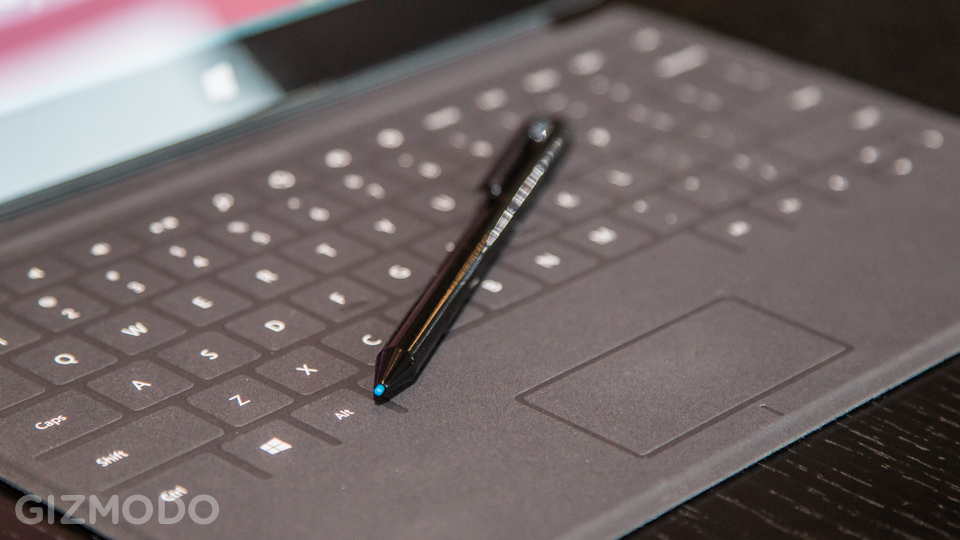
If you don’t immediately lose it, you’ll find that the Surface Pro stylus is exactly the same, including the horrible way it attached to the tablet proper: by snapping into the power port that you use for, you know, power. Worse, even if the power port is empty, attaching the Surface to another display via the Minidisplay port will also make it impossible to attach the stylus. None of this makes any sense.
Neither does the fact that the only time you genuinely need the stylus — attempting to handle desktop mode in tablet form — it won’t be there. Why? Because trying to hold the Surface Pro like a tablet when the pen is “attached” to the side is awful, and borderline impossible. The second you pick up the Surface, you will take off the stylus, set it down and forget where.
When you can actually find it and use it in a situation that doesn’t make you want to snap the Surface Pro 2 in half, the stylus itself is fantastic. But the fact that it’s still so tacked on to the physical design is maddening.
Touch and Type Cover Wireless Adaptor
Then there’s a wireless adaptor for Touch and Type covers alike, which affords a new and bizarre kind of freedom. Yes, you can now hammer away on a disembodied Touch/Type Cover. It’s all kinds of weird, but also a nice option to have. Since acclimating to either flavour of cover requires a bit of use, it’s an added convenience for the either to fit into settings where you might want a Pro and another screen side-by-side with a keyboard in between. You still might rather a traditional keyboard in those scenarios, but now you don’t need one, and can reap the benefits of getting super familiar with one and only one keyboard.
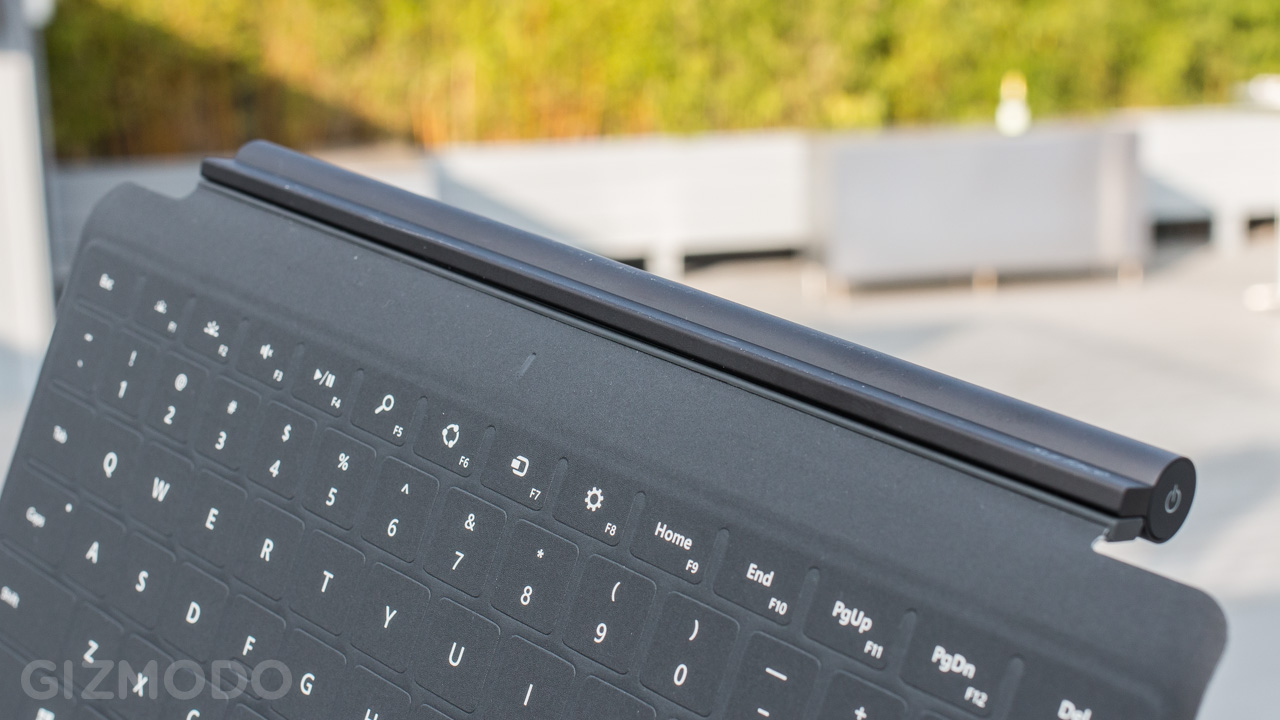
The adaptor is quite light, no heavier than a hefty pen and it’s about as nice as you can make a metallic tube. It charges via microUSB and we were able to get about 8 hours of use on a charge. But when it got low, it didn’t just stop working; instead it started triggering some weird keypresses. It was strange.
And of course none of this is free. Or even included. Despite the fact that you pretty much need a keyboard cover of some sort to make dual-role promise of the Surface Pro 2 come close to true, the new Touch Cover will cost you $US120, the Type Cover $US130, and the Wireless Adaptor $US60.
That brings the total cost of the Pro 2, with a virtually mandatory keyboard, up to over $US1000. In other words, a serious purchase. We’re talking laptop level-investment as opposed to tablet. And that’s a lot to ask.
Like
Man, this is beautiful hardware. The year that’s gone by since the launch of the first generation has done absolutely nothing to diminish the commanding presence of the Surface design. You pick one up and you want to use it, you want to love it. You think to yourself “This is a piece of hardware with which I could develop an uncomfortably intimate relationship. This is a device I want to name.” If you are going to settle down with One Device, by god it’s going to have to be something with a body like this.
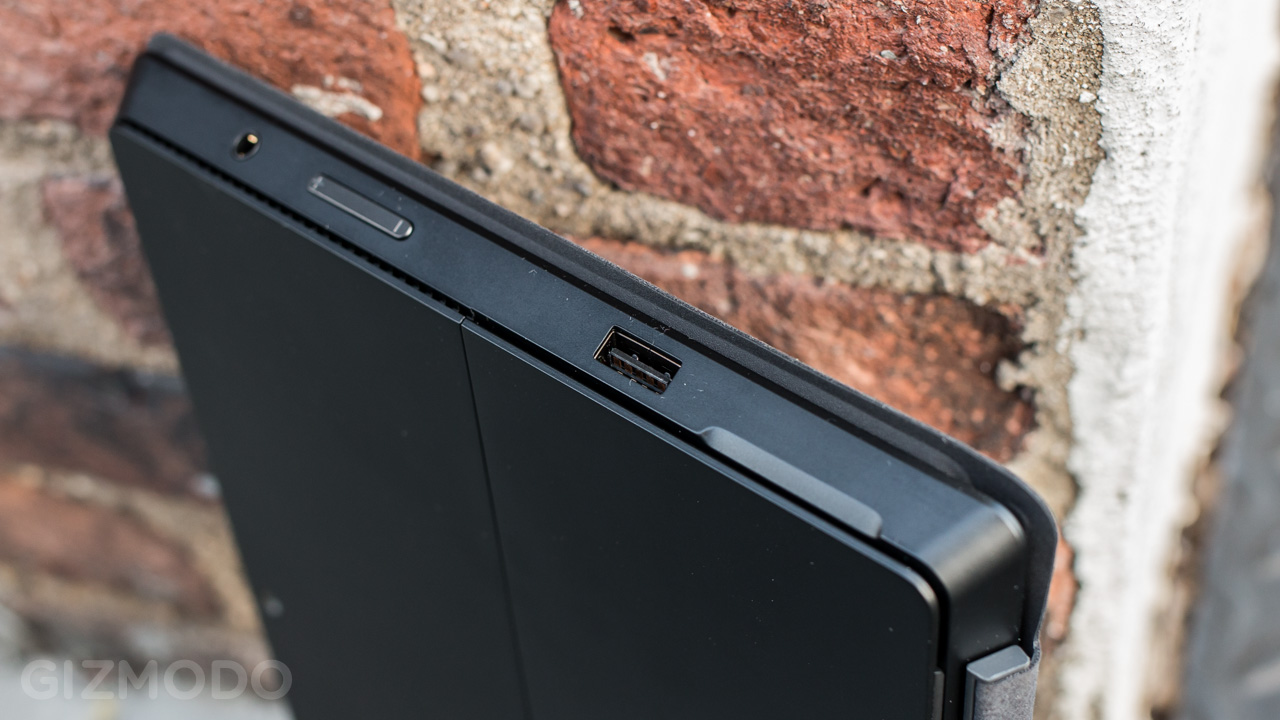
The Surface Pro 2 is also a much-improved laptop. Spec bumps are boring, but they’re also necessary and great. The Surface Pro was no slouch, but the Pro 2 brings all the power of Intel’s Haswell chipset to bear, power that manifests in better standby battery life and graphics performance that actually makes it a workable PC for modern gaming, if not a gaming PC. And that on top of your standard year-over-year improvements.
In short, everything that’s was wonderful about the Surface Pro is still wonderful about the Surface Pro 2, except now there’s also another setting for your kickstand and it’s a better computer.
No Like
But almost everything that wasn’t wonderful about the Surface Pro is still present in the Surface Pro 2. Perhaps most telling — and troubling — are the systemic issues that a spec bump can’t fix.
There’s a great laptop inside this device, and a great tablet inside it too. But the connective tissue between the two that falls short, and both sides of the equation are weaker for it. Often the best thing about a laptop is that it is very much not a tablet, and vice versa. And the limitations of a stalwartly singular device can be gauged and worked around. This is the weird way I have to sit on the couch with my laptop, so be it!
The Surface Pro is a laptop suited for desks and less so for laps. It is also a tablet for holding with two hands. That’s a nice pair of skills, but it also requires you to give up literally everything in between. If this were some sort of cheapo curiosity you could afford to take a flier on, then sure. But it’s not. This is, all in, more than a thousand dollars out of your pocket, spent on one thing that’s trying to be two things and isn’t as good as either of them.
Test Notes
- Just like the original Surface Pro, our battery tests showed a little weirdness. 20 Chrome tabs and a 10-hour YouTube video gave us just two hours and 42 minutes of power, but all other tests offered up more (around three and a half hours). Haswell also affords more battery power in between sessions of use, thanks to smarter sleep states, and while it’d still be unreasonable to expect a Surface Pro 2 to last for weeks of periodic usage without a charge like real tablets do, it fairs much better than the Pro.
- It’s worth mentioning the Windows Store. The Surface Pro 2 can run any and all full-Windows applications, but in tablet mode it’s generally unfeasible/unpleasant to use anything other than Metro. The Windows Store is nowhere near as sparse as it used to be — there are now official Facebook and Twitter apps, thank god — but it’s still the weakest major app ecosystem out there.
- The Surface Pro 2 has a pressure-sensitive Wacom-tech screen. This is fantastic! If you need it. If you are the kind of person who needs it, you are probably well aware of that and it makes the Surface Pro 2 a much more compelling purchase. For the average consumer though, it’s pretty superfluous. It’s also pretty much exactly the same as it was on the Surface Pro.
- Windows 8.1 introduced some buried but helpful multiple-monitor scaling settings that are quite helpful when using more than one monitor. The only thing is that they refused to work with the Surface Pro 2, for some reason. We were stuck choosing one option over both displays, ugh. Also, scaling issues still persist in that if you set the Pro 2 to enlarge all your applications by, say 150 per cent, many of them come out fuzzy. This includes big guys like Chrome, and to a lesser extent Steam.
Should You Buy It?
If you found nothing compelling about the Surface Pro, there’s little here to change your mind. The appeal is still pretty niche. This device is largely for professionals who have some sort of specific need for ultra-portability mixed with a full-featured OS. That or a pressure-sensitive screen with a good stylus. In those fields the Surface Pro succeeds, and the Pro 2 is a better Surface.
For most folks though, it’s probably not worth it. The Surface Pro starts at $1019 for the 64GB model, which doesn’t include the addition of the $139.99 and $149.99 Touch or Type Cover. Consider too that if you already own a tablet, the Surface Pro 2’s tabletness almost definitely not better than what you’ve already got. It’s got more power, sure. But there are precious few opportunities to use it.
The Surface Pro 2, like the Surface Pro before it, aspires to be All Things to All People. But you are not All People. You are A Person, and there are a wealth of options out there that can and probably do fit your exact needs more specifically. Surface may still very well be the future. That just doesn’t do you much good today.
Specs as tested:
Display: 10.6-inch ClearType 1920×1080 (207PPI)
Processor: Intel Core i5 Haswell
Graphics: Intel HD Graphics 4000
Memory: 4GB
Storage: 64GB SSD
Ports: Full-size USB 3.0, microSDXC card slot, Headset jack, Mini DisplayPort, Cover port
Cameras: Two 720p HD LifeCams, front- and rear-facing
Dimensions: 10.81 x 6.81 x 0.53in
Weight: 2 pounds
Price: $1019 base + $139.99 for Touch Cover, + $149.99 Type Cover
